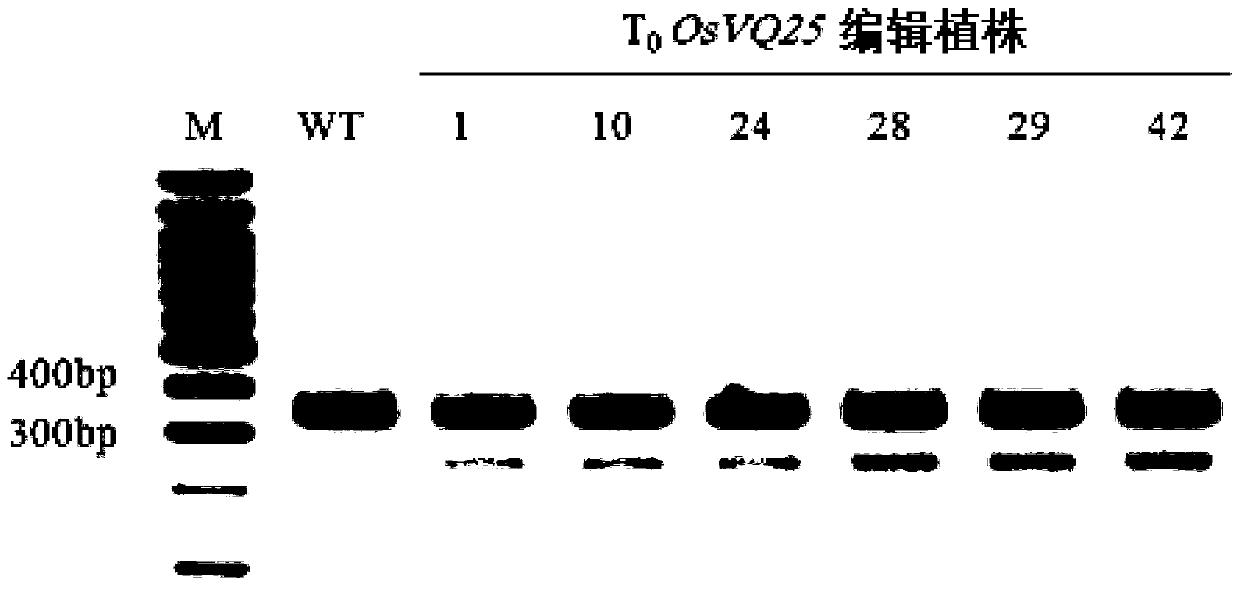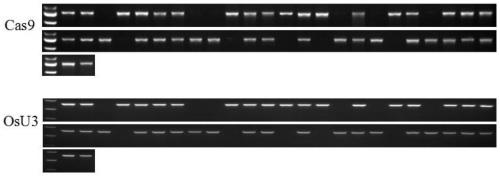Method for improving disease resistance of rice through genome editing and sgRNA used in method
A gene editing and transgenic rice technology, applied in the biological field, can solve problems such as difficult to achieve shape-oriented improvement, difficult to achieve precise point mutation, and heavy workload
- Summary
- Abstract
- Description
- Claims
- Application Information
AI Technical Summary
Problems solved by technology
Method used
Image
Examples
Embodiment 1
[0084] Embodiment 1, preparation recombinant plasmid
[0085] Artificially synthesized recombinant plasmid pCXUN-Cas9-gRNA. The recombinant plasmid pCXUN-Cas9-gRNA is a circular plasmid.
[0086] The nucleotide sequence of the recombinant plasmid pCXUN-Cas9-gRNA is shown in SEQ ID NO:1. SEQ ID NO: 1 from the 5' end, 109-361 nucleotides are reverse complementary to the NOS terminator, 386-4516 nucleotides are reverse complementary to the coding gene of Cas9 protein, 4537-6527 The nucleotide is reverse complementary to the Ubi promoter, the 6751-7154 nucleotide is the U3 promoter, the 7155-7257 nucleotide is the coding gene of the sgRNA (the 7155-7174 nucleotide is the target sequence identification area). The recombinant plasmid pCXUN-Cas9-gRNA expresses sgRNA, and the target sequence of sgRNA is located in the rice OsVQ25 gene.
[0087] The nucleotide sequence of the rice OsVQ25 gene is shown in SEQ ID NO: 2 (genome DNA) or SEQ ID NO: 4 (coding region). From the 5' end of...
Embodiment 2
[0088] Example 2, the acquisition of gene-edited rice and the detection of its traits
[0089] 1. T 0 Acquisition of regenerated plants
[0090] 1. Introduce the recombinant plasmid pCXUN-Cas9-gRNA into Agrobacterium EHA105 to obtain recombinant Agrobacterium.
[0091] 2. Using the genetic transformation method mediated by Agrobacterium, the recombinant Agrobacterium was introduced into Nipponbare to obtain T 0 generation of regenerated plants. Specific steps are as follows:
[0092] (1) Resuspend recombinant Agrobacterium with AAM medium to obtain OD 600nm Bacterial suspension with a value of 0.3-0.5.
[0093] AAM medium: Dissolve 4.3g MS salts&vitamins salt (product of PhytoTechnology), 68.5g sucrose, 0.5g MES, 36g glucose, 500mg casamino acids, 100mL 10×AA amino acids solution and 40mg acetosyringone in deionized water , then adjust the pH value to 5.2, dilute to 1L with deionized water; sterilize at 121°C for 30min.
[0094] 10×AA amino acids solution: Dissolve 8.76...
PUM
 Login to View More
Login to View More Abstract
Description
Claims
Application Information
 Login to View More
Login to View More - R&D
- Intellectual Property
- Life Sciences
- Materials
- Tech Scout
- Unparalleled Data Quality
- Higher Quality Content
- 60% Fewer Hallucinations
Browse by: Latest US Patents, China's latest patents, Technical Efficacy Thesaurus, Application Domain, Technology Topic, Popular Technical Reports.
© 2025 PatSnap. All rights reserved.Legal|Privacy policy|Modern Slavery Act Transparency Statement|Sitemap|About US| Contact US: help@patsnap.com



